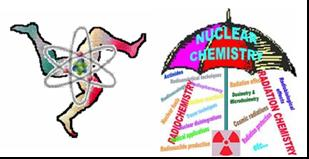Description
Radiochemistry
Constantin Papastefanou
(Aristotle University of Thessaloniki, Department of Physics, Atomic and Nuclear Physics Laboratory)
21/09/2011, 08:30
Nuclear Chemistry and Radiochemistry
oral presentation
The aerodynamic size distributions of radon decay product aerosols, i.e. 214Pb, 212Pb, and 210Pb were measured using low-pressure (LPI) as well as conventional low-volume 1-ACFM and high-volume (HVI) cascade impactors. The activity size distribution of 214Pb and 212Pb was largely associated with submicron aerosols in the accumulation mode (0.08 to 2.0 μm). The activity median aerodynamic...
Dr
Manuel Navarrete
(National University of Mexico)
21/09/2011, 08:50
Nuclear Chemistry and Radiochemistry
oral presentation
During a time period little longer than 60 years, it has been created a radioactive pollution background over the natural one, which started in 1945 and it has been growing up since then, due to several nuclear tests, minor nuclear reactors failure and four major accidents: Wind Scale, Three Mile Island, Chernobyl and Fukushima. This radioactive polluting background can be easily detected...
Dr
Shun Sekimoto
(Kyoto University Research Reactor Institute (KURRI))
21/09/2011, 09:10
Nuclear Chemistry and Radiochemistry
oral presentation
High-energy proton beams traveling in air and beam sprays from the interaction of the beam with the target and related target station components produce radioactive aerosols in the target area. We report on the measurements of the radioactive aerosols produced in the Fermilab Anti-proton target station (AP0), where 120-GeV proton beam interacts with an Inconel target. Radioactive aerosols are...
Mr
Zhi Zhang
(China Academy of Engineering Physics)
21/09/2011, 09:25
Nuclear Chemistry and Radiochemistry
oral presentation
In order to measure the helium release accurately, many methods including thermal desorption, P-V-T, mass spectrometric analyses and calorimetric measurements have been used. The article provides competitive measure methods of D-T isotope exchange, thermal desorption and aqua fortis dissolution to study helium release from PdTx. The methods of D-T isotope exchange and aqua fortis dissolution...
Dr
Marina B. Agostini Vasconcellos
(IPEN - CNEN/SP)
21/09/2011, 09:40
Nuclear Chemistry and Radiochemistry
oral presentation
Studies on the coast of São Paulo identified contamination in water and sediment samples in the region of Santos, and bioaccumulation of contaminants in marine organisms. Based on these studies, there was a need to assess exposure and effects of trace elements in a sentinel organism in this region, by using the bivalve Perna perna. The mussels were evaluated for bioaccumulation of As, Co, Cr,...
Trinidad Martinez
(National University of Mexico)
21/09/2011, 09:55
Nuclear Chemistry and Radiochemistry
oral presentation
The validity of a specific method should be demonstrated in laboratory experiments using samples or standards that are similar to unknown samples analyzed routinely. Aim of this work is the validation of γ the spectrometry technique to determine potassium in foodstuffs. It was evaluated the accuracy spiking a blank of calcium carbonate sigma ultra purity (potassium concentration lesser than...
Dr
Manuel Navarrete
(Faculty of Chemistry, National University of Mexico)
21/09/2011, 10:10
Nuclear Chemistry and Radiochemistry
oral presentation
It is very well known from ancient times that fulvic acids present in Nature as a component of dead leaves and vegetables, are the active principle which promotes better crops , acting on mineral ions in soils by picking up them into plants tissues at higher concentrations. Tested in mice, by using radioactive labeled ions such as 32PO4---, 45Ca++, 59Fe+++ and 131I-, fulvic acids have...
